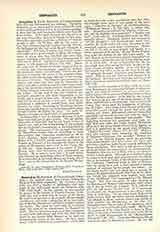

Gennadius of Marseilles (GENNADIUS SCHOLASTICUS), a priest whose chief title to fame is his continuation of St. Jerome’s catalogue “De Viris illustribus”. Nothing is known of his life, save what he tells us himself in the last (xcvii) of the biographies in question: “I, Gennadius, presbyter of Massilia, wrote eight books against all heresies, five books against Nestorius, ten books against Eutyches, three books against Pelagius, a treatise on the thousand years of the Apocalypse of John, this work, and a letter about my faith sent to blessed Gelasius, bishop of the city of Rome” (ed. Bernoulli, 95). This fixes his period ore or less: Gelasius reigned from 492-496, so Gennadius must have lived at the end of the fifth century.
Internal evidence shows that he was a Semipelagian, as indeed the name of his city would make one suspect. Of all the works to which he refers, only the “De Viris illustribus”—”this work”—is certainly extant. He tells us further that he translated and restored to their authentic form Evagrius Ponticus‘s works (Xi, 65), and those of Timothy Aelurus (lxxii, 86). These translations are also lost. He twice mentions a “catalogue of heretics” that he means to write (xxv, 74, and liii, 79). Presumably this is the work “against all heresies” referred to above. There is a pseudo-Augustinian treatise, “De ecclesiasticis dogmatibus” (P.L., LVIII, 979-1054), that is now universally attributed to Gennadius. The only question is with which of the works he speaks of having written the last-mentioned should be identified. It has often been thought to be the letter to Gelasius. Caspari (op. cit. infra), Bardenhewer, Czapla, and others have pointed out that the treatise has nothing of the nature of a letter or of a personal profession of faith. Only once, in chap. xxiii, does the author write in the first person (laudo, vitupero, etc.). They think therefore that it is more probably a fragment of Gennadius’s eight books “against all heresies”, apparently the last part, in which, having confuted the heretics, he builds up a positive system.
There are many indications that the author was a Semipelagian in Gennadius’s chapters “De Viris illustribus”. Semipelagians are warmly praised (Fastidiosus, lvi, p. 80; Cassian, lxi, 81; Faustus, lxxxv, 89); full Pelagians (Pelagius himself, xlii, 77; Julian of Eclanum, xlv, 77) are heretics; Catholics are treated shabbily (Augustine, xxxviii, 75; Prosper of Aquitania, lxxxiv, 89); even popes are called heretics (Julius I, in i, 61). The same tendency is confirmed by the treatise “De eccles. dogmatibus”, which is full of Semipelagianism, either open or implied (original sin carefully evaded, great insistence on free will and denial of predestination, grace as an adjutorium in the mildest form, etc.; cf. Wiggers, op. cit. infra, 353 sqq.). Perhaps the most reprehensible effect of Gennadius’s opinions on this point is his sneering remark about St. Augustine’s prolific genius: “He wrote so much that it cannot all be found. For who shall boast of possessing all his works, of who shall read with as much care as he used in writing?” And at the end he tempers his faint praise by saying that Augustine “caused doubts about the question of unborn children to the simple” and that he “remained a Catholic” (xxxviii, 75). To say of Augustine merely that he remained a Catholic, shows prejudice, if anything can.
We have said that Gennadius’s chief, if not his only, title to fame is his continuation of St. Jerome’s “De Viris illustribus”. In that work Jerome had for the first time drawn up a series of one hundred and thirty-five short biographies of famous Christians, with lists of their chief works. It was the first patrology and dictionary of Christian biography. So useful a book of reference naturally became popular, and while no one thought of controlling or correcting it, many people wrote continuations after the same method. We hear of such a continuation by one Paterius, a disciple of Jerome, and of a Greek translation by Sophronius. But it was Gennadius’s continuation that won most favor, that was accepted everywhere as a second part of the same work, and was always written (eventually printed) together with St. Jerome’s work. Gennadius’s part contains about one hundred lives (variously numbered: by Bernoulli, i to xcvii, with some marked as xciib, etc., originally cxxxvi-ccxxxii), modeled strictly on those of Jerome. In xc, 92, he says (in one version) that Theodore of Coelesyria (Theodulus) “died three years ago, in the reign of Zeno. From this Czapla deduces that Gennadius wrote between 491 and 4 The series is arranged more or less in chronological order, but there are frequent exceptions. The text is in a bad state. Other people have modified it and added to it without noting the fact—as is usual among medieval writers. Richardson (op. cit. infra) and Czapla consider, apparently with reason, that chapters xxx (John of Jerusalem), lxxxvii (Victorinus), xciii (Caerealis of Africa), and all the end portion (xcv-ci), are not authentic. There is doubt about parts of the others. Gennadius was on the whole an honorable and scrupulous writer. In one place (lxxxv, 90) he says: “There are other works by him (Faustus) which I will not name because I have not yet read them.” He uses the name “Scholasticus” as an honorable epithet repeatedly (lxiii, 82, lxvii, 84, lxxix, 87, lxxxiv, 89). It is generally, and very justly, given to him by others.
ADRIAN FORTESCUE

